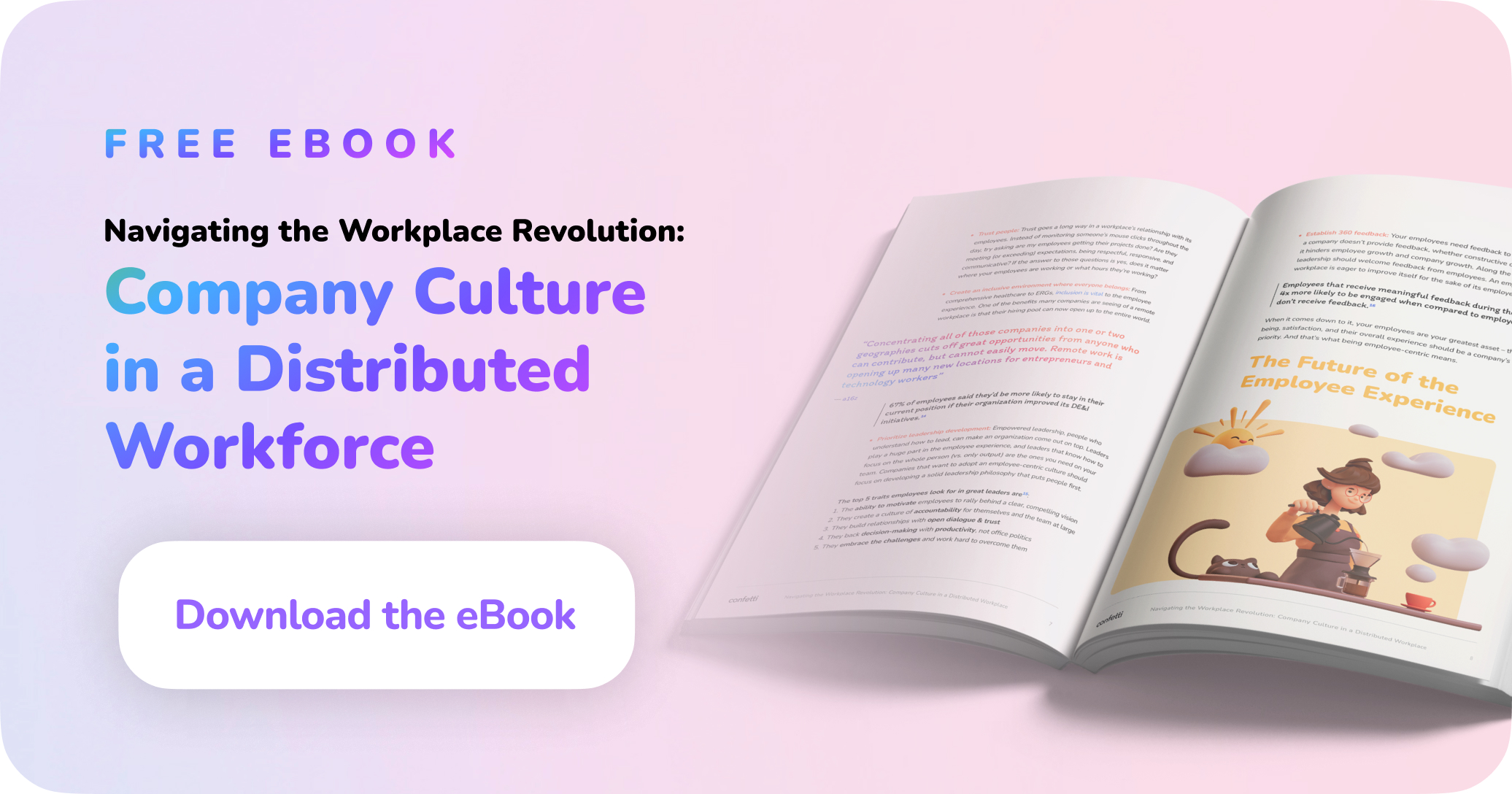
5 Remote Leadership Skills Necessary for Success
Confetti's CEO, Lee Rubin, discussed the 5 key skills needed to develop a strong remote leadership culture. Read to learn more.



Confetti's CEO, Lee Rubin, discussed the 5 key skills needed to develop a strong remote leadership culture. Read to learn more.


Dynamic remote leadership means keeping your team on task, helping others accomplish personal and departmental goals, and ensuring employee expectations are aligned (all from afar). The best remote leaders have a hand in an employee’s success from the beginning and invest in it long term.
I’ve found a few tools, tips, and skills that have been invaluable to my growth as the CEO of Confetti (a fully remote company), and I’d love to share them with you. Keep reading for insight into the remote leadership skills I think are necessary to succeed.
To be a successful remote leader, you have to align expectations from the very beginning. This includes seeing eye-to-eye on workflows, company values, career goals (yes, including salaries), and much more.
As a fully remote company, we’re continuously adapting our interview process to ensure we’re bringing in the right people. Making your expectations clear and ensuring they’re understood, will involve meaningful conversations that begin before someone accepts the job. Three significant takeaways I’d like to highlight are:
At Confetti, we give trust as a default. We don’t have clock-in/clock-out procedures, and we don’t do mouse or keyboard tracking. Working hours are flexible, so long as a persons’ role allows it, and people are welcome to travel so long as the work gets done. Our hiring process already told us we’re onboarding someone who we can trust to get their job done efficiently and effectively.
Priming your team with the best available resources and training is a leadership skill required for all instances, not only remote. But the type of training needed and the tools your team needs vary. If you haven’t already, build a company playbook. Documentation, documentation, documentation!
Onboarding exposes new hires to different departments, people, operations, procedures, company values, future goals — the list goes on. In short, it’s a lot of information. And there are plenty of ways to optimize your onboarding practices.
We’ve found a pillar of onboarding best practices for the remote workplace includes implementing a buddy or mentor system. This gives your latest employee a direct point person they know they can turn to for additional support and clarity as they adjust to their workflow. Plus, it’s an opportunity for their buddy to show management potential. They both need to work together to succeed
Additionally, it’s important to realize onboarding extends beyond the initial training period. Utilize the first 90 days to your advantage by having HR and their mentor routinely check-in to see how the individual is adjusting. At Confetti, these check-ins go as follows:
Establishing this structured relationship with their manager and HR will help your employee feel more comfortable being on their own, as you’ve continuously made your support available.
Not everyone has the ideal work-from-home set-up, so it’s up to leadership to ensure their employees can work comfortably when remote.
Confetti provides laptops and offers a generous stipend for other supplies, including additional monitors, desks, and chairs. To streamline the process and get employees what they need right away, purchases like this are pre-approved up to a certain amount.
Successful leaders make a habit of ensuring the company has values created for the people within the organization.
Hold people accountable for upholding the best values and processes your company has. Revisit values to ensure what’s there helps your business run efficiently and maintains your staff's well-being.
A few of Confetti’s values include:
It’s easy to fall off the communication train when working from home. You don’t see your team working alongside you. Out of sight, out of mind, right? Wrong!
You’ll find remote work and remote leadership requires taking your communication game the extra mile. I’ve found a few ways to step-up the communication game, including:
Help your team with prioritizing their workload. Trust me. It’ll go a long way. Make a habit of explicitly telling team members when a project or task is urgent vs. when it’s not. Trust your team members to get things done, but don’t be afraid to follow up — sometimes people need it, and that’s okay.
To help with project prioritization, find a task management tool to streamline requests and assignments. We use Monday, as it’s easy to customize and integrate with other tools.
On top of keeping communication lines open, our leadership has weekly one-on-one meetings with individuals on their team. We have a shared list of TBDs (To Be Discussed) and judge the necessity of our meetings based on that list. In some instances, we can cancel meets all together, but in other cases, we may need to make the meetings a little longer.
These TBDs provide a chance to discuss project status, provide feedback, or even casually check how someone is doing beyond their work-life. It’s a great way to connect, revisit goals, and make sure everyone is aligned.
We’re trying (and loving) this new onboarding process, so we have to share the secret. During the initial onboarding, we have each department leader give a brief overview of their department, including information like:
Even if teams don’t work together often, their work still impacts everyone. And projects do overlap. The marketing department needs to know they’re not over-promising services in their ad campaigns because that results in customer complaints, which leads to challenges for the customer success team, and ultimately knocks a few points off of company credibility.
Having different departments explain their workflow and how each team connects provides invaluable insights into the day-to-day and helps establish the chain of communication.
Confetti prides itself on fostering a transparent, honest work environment where everyone feels comfortable, has room for growth, and feels comfortable.
Just as employees should receive feedback, employees should be able to give feedback. The success of one depends on the success of another. The employee/leadership relationship is symbiotic, and that’s why the 360 performance reviews are vital.
Company-wide feelings on policies, processes, and the day-to-day may shift over time. This is especially true for remote work.
That’s why we have our HR and PeopleOps team conduct periodic pulse checks to gauge what people are thinking, how the company can improve, and what the company needs. You can use feedback from pulse checks to grow and shape your company in a way that maintains both efficiency and employee happiness.
I hope you walk away from this article feeling a little more prepared to be the best leader you can be. The main takeaway I’d like you to get from this is to continue listening and learning to your team. Be champions of their success and employee experience, and they’ll be champions of yours.
P.S. I’m rooting for you. 💙











